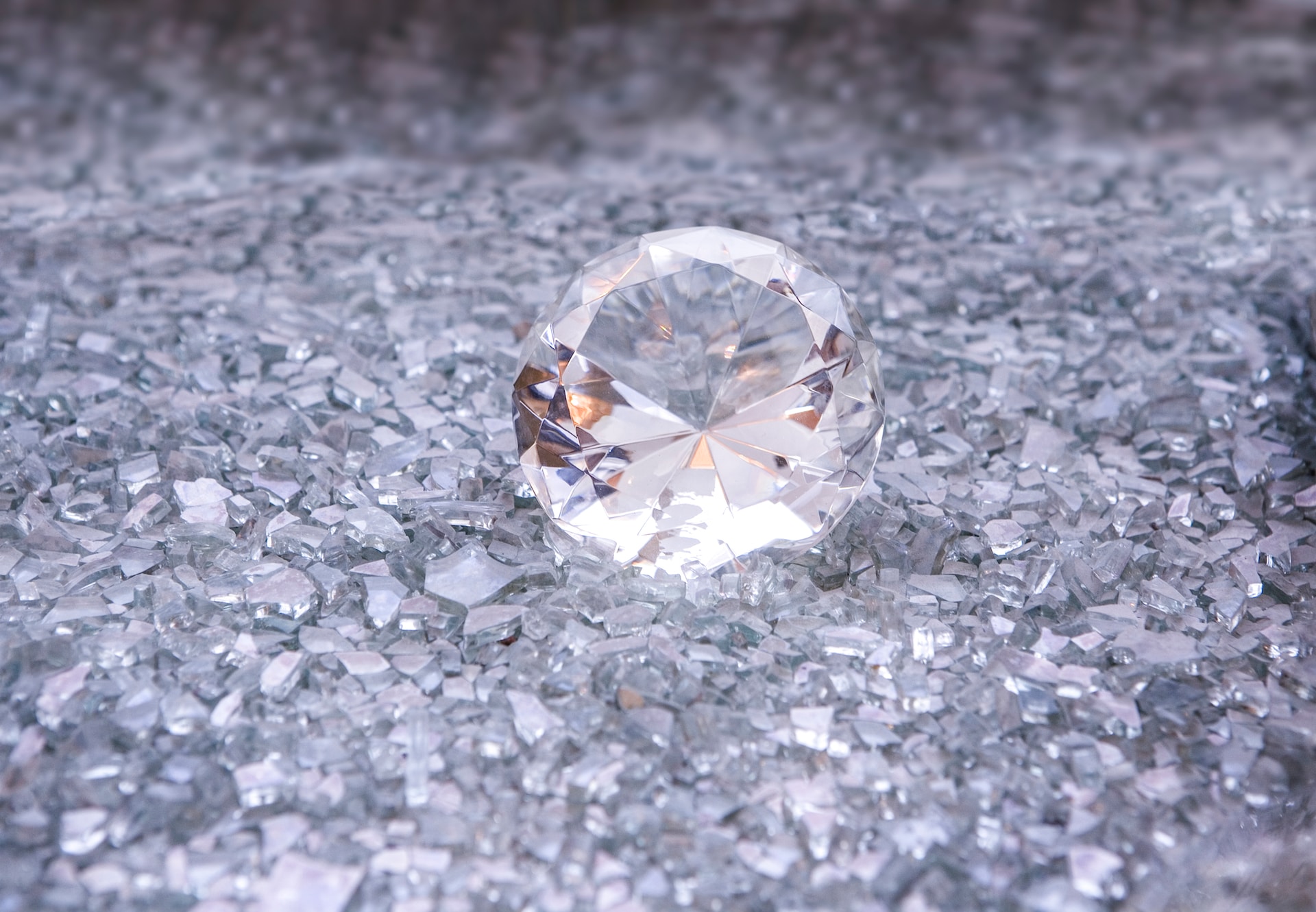Sustainability has become a major concern in many industries, including the jewelry industry. Consumers are increasingly seeking out ethical and sustainable options when it comes to their purchases, and jewelry is no exception. Moissanite, a diamond alternative, has emerged as a popular choice for those who want a beautiful and affordable option that is also ethical and environmentally friendly.
Moissanite is a lab-created gemstone that has many similarities to diamonds, but with several distinct differences. It is made from silicon carbide, rather than carbon, and is often more affordable than diamonds. Moissanite is also known for its brilliance and fire, and can be a stunning choice for engagement rings, wedding bands, and other types of jewelry.
When it comes to sustainability, moissanite has a much lower environmental impact than traditional diamond mining. Diamond mining can be incredibly destructive to the environment, with large areas of land being cleared and ecosystems being disrupted. Moissanite, on the other hand, is created in a lab and does not require any mining. This makes it a much more sustainable choice for those who are concerned about the environmental impact of their jewelry purchases.
Key Takeaways
- Moissanite is a lab-created gemstone that is a popular choice for those who want an ethical and sustainable alternative to diamonds.
- Moissanite has a much lower environmental impact than traditional diamond mining, making it a more sustainable choice.
- Moissanite is an affordable and beautiful option for engagement rings, wedding bands, and other types of jewelry.
What is Moissanite
Moissanite is a naturally occurring mineral that is composed of silicon carbide. It was first discovered in 1893 by French chemist Henri Moissan while he was examining rock samples from a meteor crater in Arizona. Moissanite is extremely rare in nature, and most of the moissanite used in jewelry today is created in a laboratory.
Moissanite has become a popular alternative to diamonds in jewelry due to its brilliance, durability, and affordability. It has a higher refractive index than diamonds, which means that it reflects more light and has more sparkle. Moissanite is also harder than other gemstones, making it less likely to scratch or chip.
Moissanite is often compared to diamonds, but it is important to note that they are two different stones with their own unique characteristics. While moissanite may look similar to a diamond at first glance, it has a different chemical composition and optical properties.
Overall, moissanite is a beautiful and ethical choice for those looking for a sustainable alternative to diamond jewelry.
Moissanite Vs Diamonds
Moissanite and diamonds are two of the most popular gemstones used in jewelry. Both have their unique properties and characteristics that make them popular choices for engagement rings, wedding bands, and other jewelry pieces. In this section, we will compare moissanite and diamonds based on several factors.
Hardness
One of the most significant differences between moissanite and diamonds is their hardness. Diamonds are known for their exceptional hardness, scoring a perfect 10 on the Mohs scale. Moissanite, on the other hand, has a hardness of 9.25, making it a close second to diamonds. This means that both stones are durable and can withstand everyday wear and tear.
Brilliance and Sparkle
Both moissanite and diamonds are known for their brilliance and sparkle, but they differ in their fire. Moissanite has a higher refractive index than diamonds, which means it can disperse more light and create more fire than diamonds. However, some people prefer the classic, white sparkle of diamonds, while others prefer the rainbow-like effect of moissanite.
Colors
Diamonds come in a range of colors, from colorless to yellow, brown, and even pink or blue. Moissanite, on the other hand, is usually colorless or near-colorless. Some people prefer the colorless look of moissanite, while others prefer the unique colors of diamonds.
Clarity
Both moissanite and diamonds can have inclusions or blemishes, which can affect their clarity. However, diamonds are generally more expensive when they have higher clarity grades, while moissanite is usually less expensive regardless of clarity.
In summary, moissanite and diamonds have their unique properties and characteristics that make them popular choices for jewelry. While diamonds are known for their exceptional hardness and classic sparkle, moissanite offers a rainbow-like effect and is usually less expensive. Ultimately, the choice between moissanite and diamonds comes down to personal preference and budget.
The Ethical and Environmental Impact of Traditional Jewelry
Traditional diamond jewelry has a significant environmental and social impact. The mining of diamonds requires vast amounts of energy and water, leading to soil erosion and deforestation. Additionally, diamond mining causes pollution, including water and air pollution, which can harm local communities and wildlife.
The mining of diamonds is also associated with forced labor and human rights abuses. Many diamond mines are located in developing countries with weak labor laws, leading to exploitation of workers. Traditional diamond mining also often has a negative impact on local communities, displacing people from their homes and disrupting their way of life.
The production of traditional jewelry is also associated with environmental and social impacts. The mining of metals and gemstones requires significant energy and water usage, leading to pollution and environmental degradation. The production of traditional jewelry also often involves forced labor and exploitation of workers.
Overall, the traditional diamond jewelry industry has a significant impact on the environment and local communities. It is important to consider the ethical and environmental impact of jewelry when making purchasing decisions, and to seek out sustainable and ethical alternatives.
Sustainability and Moissanite Jewelry
Moissanite jewelry is a sustainable option for those who want to make a commitment to sustainability. Unlike diamonds, which are mined from the earth, moissanite is created in a lab, making it a more eco-friendly and sustainable option.
The production of moissanite also has a lower environmental impact compared to diamond mining, which often involves land disturbance, water pollution, and other negative effects on the environment. By choosing moissanite jewelry, consumers can reduce their carbon footprint and contribute to a more sustainable future.
In addition to being a sustainable option, moissanite jewelry is also produced using ethical production methods. This means that the workers involved in the production process are treated fairly and work in safe conditions. Moissanite companies often have a commitment to sustainability and ethical production, which is reflected in their business practices.
Overall, moissanite jewelry provides a sustainable and ethical alternative to traditional diamond jewelry. By choosing moissanite, consumers can make a positive impact on the environment while still enjoying beautiful and high-quality jewelry.
The Value and Affordability of Moissanite
Moissanite is a gemstone that has been gaining popularity in recent years due to its affordability and value. While diamonds are often seen as the ultimate symbol of luxury and love, moissanite offers a more ethical and sustainable option for those who want a beautiful, high-quality gemstone without breaking the bank.
One of the main reasons moissanite is so affordable is because it is produced in a lab, rather than being mined from the earth. This means that production costs are significantly lower than they are for diamonds, which must be mined, cut, and polished before they can be sold. As a result, moissanite is often priced at a fraction of the cost of a comparable diamond.
But just because moissanite is more affordable than diamonds doesn’t mean it is any less valuable. In fact, moissanite is a highly sought-after gemstone in its own right, prized for its brilliance, fire, and durability. It is also a more ethical and sustainable choice than diamonds, which are often associated with environmental destruction and human rights abuses.
Overall, moissanite offers excellent value for those who want a beautiful, high-quality gemstone without the high price tag. Whether you’re looking for an engagement ring, a pair of earrings, or a pendant necklace, moissanite is a great choice that won’t break the bank.
Quality and Durability of Moissanite
Moissanite is a high-quality gemstone that has been gaining popularity in recent years as an ethical and sustainable alternative to traditional diamonds. One of the key factors that make moissanite an attractive option is its durability.
Moissanite is a very hard and durable gemstone, scoring 9.25 on the Mohs scale of hardness. This makes it one of the hardest gemstones available and ensures that it can withstand daily wear and tear without scratching or chipping. In comparison, diamonds score 10 on the Mohs scale, making them slightly harder than moissanite, but the difference in hardness is not significant enough to affect moissanite’s durability.
Furthermore, moissanite is resistant to heat, making it a suitable choice for jewelry that is exposed to high temperatures, such as engagement rings. It is also highly resistant to chemicals, making it a low-maintenance gemstone that can be easily cleaned with soap and water.
In terms of quality, moissanite is a high-quality gemstone that is almost as brilliant as a diamond. It has a refractive index of 2.65-2.69, which is higher than that of a diamond, giving it excellent fire and brilliance. Moissanite is also free of inclusions and blemishes, ensuring that it has a clear and flawless appearance.
Overall, moissanite is a durable and high-quality gemstone that is an excellent choice for those looking for an ethical and sustainable alternative to traditional diamonds. Its durability and quality make it a great option for engagement rings and other jewelry that is worn daily.
The Aesthetics of Moissanite Jewelry
Moissanite jewelry is renowned for its stunning beauty and sparkle. The unique optical properties of moissanite make it an excellent choice for jewelry, especially for those who value sustainability and ethical sourcing.
Moissanite has a high refractive index, making it more brilliant than diamonds. It also has a high dispersion, which creates a rainbow-like effect when light passes through it. This combination of brilliance and fire gives moissanite jewelry a dazzling appearance that is sure to catch the eye.
In terms of luster, moissanite has a similar appearance to diamonds, with a bright and reflective surface that adds to its overall appeal. Moissanite is also available in a wide range of shapes and sizes, making it a versatile choice for any jewelry style.
Moissanite earrings are a popular choice for those looking to add some sparkle to their everyday look. The brilliance and fire of moissanite make it an excellent choice for earrings, as it catches the light and adds a touch of glamour to any outfit.
For those looking for an ethical and sustainable engagement ring option, especially 3ct moissanite rings, moissanite is an excellent choice. It has a similar appearance to diamonds, but without the environmental and ethical concerns associated with diamond mining.
Overall, moissanite jewelry is a beautiful and ethical choice for those looking for sustainable and stunning jewelry options.
Ethical Choice: Supporting Moissanite
Moissanite is a sustainable and ethical alternative to traditional diamonds. It is a lab-created gemstone that has the same brilliance and fire as a diamond, but without the environmental and ethical concerns associated with diamond mining. Choosing moissanite jewelry is a responsible and ethical choice that supports sustainable and ethical values.
By supporting moissanite, you are supporting ethical and responsible practices in the jewelry industry. Moissanite is created in a controlled laboratory environment, which means that there is no environmental damage or exploitation of workers associated with its production. Additionally, moissanite is not associated with any political conflicts or human rights abuses, making it a feel-good choice for those who value ethical and responsible practices.
When you choose moissanite jewelry, you can feel confident that you are making an ethical choice that aligns with your values. Moissanite is a beautiful and sustainable option that allows you to enjoy the beauty and luxury of fine jewelry without compromising your ethics. So why not choose moissanite and support ethical and sustainable values in the jewelry industry?
Moissanite in the Fashion Industry
Moissanite is a gemstone that has become increasingly popular in the fashion industry due to its resemblance to diamonds and its sustainable and ethical qualities. As consumers become more conscious of the environmental and social impact of their purchases, moissanite jewelry has emerged as a viable alternative to traditional diamond jewelry.
Sustainable fashion is a growing trend in the fashion industry, and moissanite jewelry fits perfectly into this category. Moissanite is a lab-grown gemstone, which means it has a significantly lower carbon footprint than mined diamonds. Additionally, moissanite is created without the use of environmentally damaging mining practices, which can have a devastating impact on local ecosystems.
Celebrities have also played a role in the rise of moissanite jewelry. Many high-profile individuals have been spotted wearing moissanite engagement rings and other jewelry pieces. This has helped to elevate the status of moissanite and position it as a luxury item in its own right.
Moissanite is also known for its high-quality and durability. It has a hardness rating of 9.25 on the Mohs scale, making it one of the hardest gemstones available. This means that moissanite jewelry is able to withstand daily wear and tear without losing its shine or brilliance.
Overall, moissanite jewelry offers a sustainable and ethical alternative to traditional diamond jewelry. Its popularity in the fashion industry is only set to grow as more consumers become aware of its benefits and as sustainable fashion continues to gain traction.
Consumer Perception and Demand for Moissanite
Consumer perception and demand for moissanite jewelry have been on the rise in recent years. As consumers become more aware of the environmental and ethical concerns associated with diamond mining, they are turning to alternative options like moissanite.
Moissanite is a diamond alternative that is highly sought after by jewelry enthusiasts. It has a similar brilliance and fire to diamonds and is often indistinguishable to the naked eye. Additionally, moissanite is more affordable than diamonds, making it an attractive option for budget-conscious consumers.
According to a survey conducted by The Natural Diamond Council, 66% of millennials believe that lab-grown diamonds are a good alternative to mined diamonds. This shift in consumer perception has led to an increase in demand for alternative options like moissanite.
In addition to its affordability and environmental benefits, moissanite is also a durable and long-lasting gemstone. It has a hardness level of 9.25 on the Mohs scale, making it suitable for everyday wear. This durability has made moissanite a popular choice for engagement rings and other jewelry pieces that are worn daily.
Overall, consumer perception and demand for moissanite are on the rise as consumers become more aware of the environmental and ethical concerns associated with diamond mining. As an affordable and durable diamond alternative, moissanite is an attractive option for consumers looking for sustainable and ethical jewelry options.
The Future of Moissanite and Sustainable Jewelry
Moissanite is a lab-created mineral that has been gaining popularity in the jewelry industry due to its affordability, durability, and environmental sustainability. As technology advances, moissanite is likely to become an even more popular choice for sustainable jewelry.
Moissanite is created in laboratories using advanced technology that ensures a high-quality product. This process is much more sustainable than mining for natural gemstones, which can have a significant impact on the environment. Additionally, moissanite is a conflict-free alternative to traditional diamonds, which can be sourced from areas with human rights abuses.
As more consumers become aware of the environmental and ethical impact of their purchases, the demand for sustainable jewelry is likely to increase. Moissanite offers a viable alternative to traditional gemstones, and as technology improves, the quality and affordability of moissanite jewelry will continue to improve.
Laboratories that create moissanite are also likely to become more prevalent in the future, as demand for sustainable jewelry increases. These labs are highly controlled environments that ensure the quality and consistency of the product. As more labs are established, the supply of moissanite will increase, making it more accessible to consumers.
In conclusion, the future of moissanite and sustainable jewelry looks bright. As technology advances and more consumers become aware of the environmental and ethical impact of their purchases, moissanite is likely to become an increasingly popular choice for sustainable jewelry. Laboratories that create moissanite are also likely to become more prevalent, making moissanite more accessible to consumers.
Frequently Asked Questions
What is the difference between moissanite and diamond?
Moissanite is a gemstone that is made of silicon carbide, while diamonds are made of carbon. Moissanite has a higher refractive index than diamonds, which means it has more fire and brilliance. Moissanite is also less expensive than diamonds.
How does moissanite compare to lab-grown diamonds?
Moissanite is not a diamond, but it is often compared to lab-grown diamonds because they are both alternatives to traditional mined diamonds. Lab-grown diamonds are made of carbon, just like natural diamonds, while moissanite is made of silicon carbide. Moissanite is less expensive than lab-grown diamonds, but lab-grown diamonds are more similar in appearance to natural diamonds.
Are moissanite rings more environmentally friendly than traditional diamond rings?
Moissanite is considered a more environmentally friendly option than traditional diamond rings because it is not mined from the earth. Mining for diamonds can have a significant environmental impact, including deforestation, habitat destruction, and water pollution. Moissanite is also created in a lab, which means it uses fewer resources and produces less waste than mining for diamonds.
What are the ethical considerations when choosing moissanite jewelry?
The ethical considerations when choosing moissanite jewelry are similar to those for any other type of jewelry. Consumers should consider the working conditions and wages of the people who make the jewelry and the environmental impact of the manufacturing process. Moissanite is generally considered to be a more ethical choice than traditional diamonds because it is not mined from the earth.
Can moissanite be considered a sustainable choice for jewelry?
Moissanite can be considered a sustainable choice for jewelry because it is not mined from the earth and is created in a lab. This means that it uses fewer resources and produces less waste than mining for traditional diamonds. However, it is important to consider the environmental impact of the manufacturing process and the working conditions of the people who make the jewelry.
What are the benefits of choosing moissanite over traditional diamonds?
The benefits of choosing moissanite over traditional diamonds include cost, environmental impact, and ethical considerations. Moissanite is less expensive than diamonds, and it is not mined from the earth, which means it has a smaller environmental impact. Moissanite is also considered to be a more ethical choice than traditional diamonds because it is not associated with the human rights abuses that are often associated with diamond mining.






